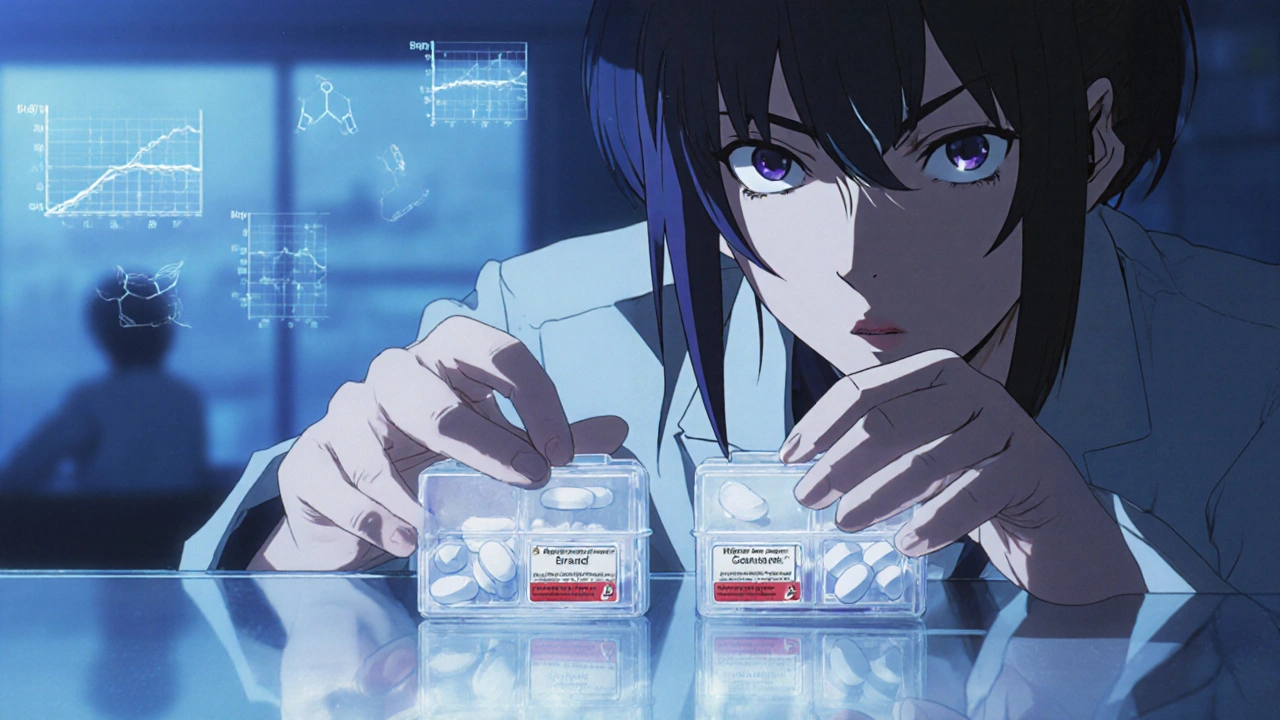When a doctor prescribes a medication like warfarin, phenytoin, or levothyroxine, the difference between a safe dose and a dangerous one can be razor-thin. These are NTI generics - narrow therapeutic index drugs - where even small changes in how the drug is absorbed can lead to serious harm or treatment failure. That’s why regulating them isn’t like approving any other generic pill. Around the world, countries have built very different systems to make sure these drugs are safe, effective, and consistent. Understanding how these systems work - and how they differ - is critical for patients, pharmacists, and manufacturers alike.
What Makes NTI Drugs So Different?
NTI drugs have a tiny window between the dose that works and the dose that causes harm. Take warfarin, for example. A 10% change in blood concentration can mean the difference between preventing a clot and causing a life-threatening bleed. Phenytoin, used for seizures, behaves the same way. Even slight variations in how a generic version is made - the ingredients, the coating, the release rate - can throw off the entire balance.
This isn’t theoretical. In 2021, a batch of generic antihypertensive drugs was recalled because of nitrosamine impurities - contaminants that can form during manufacturing. For a regular drug, that might mean a minor risk. For an NTI drug, it’s a potential public health crisis. That’s why regulators don’t treat them the same as other generics. The FDA, EMA, Health Canada, and Japan all have special rules for these drugs - and those rules are far stricter than what’s required for standard generics.
How the FDA Approves NTI Generics in the U.S.
In the United States, the FDA has been tightening the screws on NTI generics since 2010. For most generic drugs, bioequivalence is measured using an 80% to 125% range - meaning the generic’s blood concentration can be up to 25% lower or higher than the brand and still be considered equivalent. For NTI drugs, that range is often tightened to 90% to 111%, and sometimes even narrower. The quality assay - how much active ingredient is actually in each tablet - must be within 95% to 105%, not the usual 90% to 110%.
Studies for NTI generics must use healthy volunteers, not patients, so researchers can isolate the effect of the formulation without interference from other health conditions. The FDA also requires more detailed dissolution testing - how the drug breaks down in the body - and sometimes multiple studies to confirm consistency.
But approval doesn’t end at the lab. In 26 U.S. states, pharmacists can’t automatically swap a brand-name NTI drug for a generic without special permission. North Carolina requires both the doctor and patient to sign off. Connecticut, Idaho, and Illinois have extra rules for anti-seizure drugs. That’s because even if the FDA says two products are equivalent, some doctors and patients still worry about switching. A 2019 survey found 67% of U.S. pharmacists had been asked by doctors to avoid substituting NTI generics - especially for levothyroxine and warfarin.
Europe’s Patchwork System: Centralized vs. National Rules
Europe doesn’t have one rulebook. It has 27 countries, each with its own health authority - but they try to coordinate through the European Medicines Agency (EMA). The EMA offers a Centralized Procedure, which gives approval across all EU countries. About 68% of new generic applications now use this route, up from 42% in 2018. But many companies still choose the National Procedure, which means applying separately in each country - a slow, expensive mess.
The EMA’s bioequivalence standards for NTI drugs are similar to the FDA’s, but they’re applied inconsistently. A product approved under the Centralized Procedure is accepted everywhere. But if it’s approved under the National Procedure in Germany, it doesn’t automatically get approved in Spain. That creates confusion for pharmacists and patients who move between countries.
Then there’s pricing. In 24 of the 27 EU countries, governments set generic drug prices - often forcing the first generic to sell at least 40% cheaper than the brand. In Spain, every following generic must match or undercut that price. This drives down costs but also pressures manufacturers to cut corners. In contrast, the U.S. has no federal price controls, which lets manufacturers charge more - but also lets competition drive prices down over time.

Canada, Japan, and Other Key Players
Canada has taken a pragmatic approach. If a generic manufacturer wants to use a foreign reference product - say, the U.S. version of a drug - they can, as long as they prove it’s identical in formulation, solubility, and physical properties. They also need detailed multi-point dissolution profiles. This flexibility helps speed up approvals without lowering safety.
Japan’s Pharmaceuticals and Medical Devices Agency (PMDA) is known for its detailed, almost obsessive, guidance documents. For topical NTI drugs - like creams or patches - Japan has specific rules that go beyond what most other countries require. It’s not unusual for Japanese regulators to request additional stability studies or even real-world data before approving a product.
Meanwhile, countries like Brazil, Mexico, Singapore, and South Korea have little to no published guidance for NTI generics. That makes it risky for manufacturers to enter those markets. Without clear standards, a product approved in the U.S. might get rejected in Brazil - not because it’s unsafe, but because the regulator doesn’t know how to evaluate it.
Why the Global System Is Still Fragmented
There’s a global effort to fix this: the International Generic Drug Regulators Pilot (IGDRP), launched in 2012. It includes the FDA, EMA, Health Canada, PMDA, and others. The goal? Share data, align testing methods, and reduce duplication. It’s working - slowly. In 2023, the ICH adopted the M9 guideline on biowaivers, which could simplify some NTI drug approvals by allowing manufacturers to skip certain bioequivalence studies if the drug fits a specific profile.
But big differences remain. The U.S. focuses on strict bioequivalence limits and state-level substitution laws. Europe pushes for price control and centralized approval but struggles with implementation. Canada is flexible but cautious. Japan is thorough but slow. And many countries are still flying blind.

What’s Changing in 2025?
The FDA is planning to roll out population bioequivalence methods by 2025. Instead of testing just 24 healthy volunteers, they’ll use statistical models to analyze data from hundreds of people - giving a clearer picture of how different populations absorb the drug. This could make approvals more accurate and reduce the need for multiple small studies.
Also in 2023, the FDA’s GDUFA III kicked in, adding new requirements for post-market monitoring of NTI generics. That means manufacturers will have to track real-world outcomes - not just lab results. If a generic version starts showing more reports of adverse events, regulators can act faster.
Meanwhile, the EMA is pushing more companies toward the Centralized Procedure. And countries like Australia and New Zealand are watching closely, considering whether to adopt similar standards.
Real-World Impact: Patients and Pharmacists on the Front Lines
Behind all these regulations are real people. In March 2023, a pharmacist on Reddit shared a story about three patients who had thyroid level swings after switching to a different generic levothyroxine - even though both versions were FDA-approved. That’s the heart of the problem: two products can meet regulatory standards and still behave differently in the body.
On the flip side, a 2021 study of 12,500 patients across 15 European countries found that when strict bioequivalence rules were followed, NTI generics performed just as well as brand-name drugs in 94.7% of cases. That’s a powerful reminder: the issue isn’t generics themselves - it’s inconsistent standards and poor communication.
For pharmacists, the biggest headache isn’t the science - it’s the rules. In Europe, 58% said they’re confused about which generics can be swapped where. In the U.S., they’re caught between FDA guidelines and state laws. No one wants to make a mistake with a drug that could kill someone.
The Bottom Line
NTI generics are a success story - and a warning. They’ve saved billions of dollars in healthcare costs. But they also demand more precision, more oversight, and more global cooperation than any other type of medicine. The current system works - but only if you’re in the right country, with the right drug, and the right pharmacist who knows the rules.
What’s needed now isn’t more regulation - it’s alignment. Harmonized standards. Clearer communication. And a shared understanding that when it comes to drugs with a narrow therapeutic index, there’s no room for guesswork.


Hi, I'm Caden Lockhart, a pharmaceutical expert with years of experience in the industry. My passion lies in researching and developing new medications, as well as educating others about their proper use and potential side effects. I enjoy writing articles on various diseases, health supplements, and the latest treatment options available. In my free time, I love going on hikes, perusing scientific journals, and capturing the world through my lens. Through my work, I strive to make a positive impact on patients' lives and contribute to the advancement of medical science.